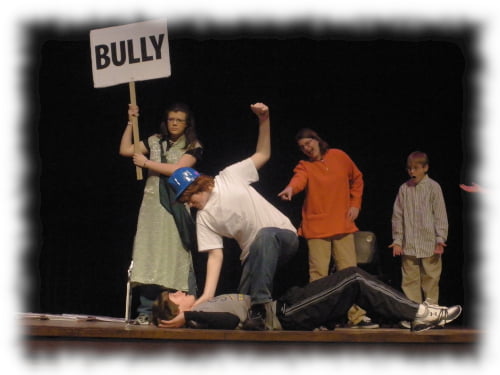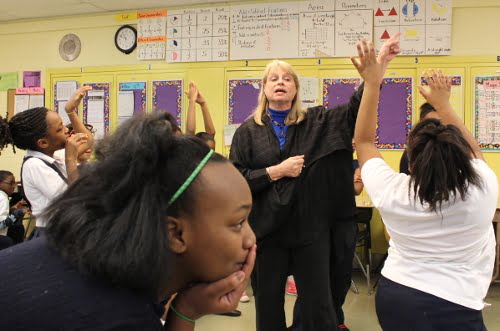Some of you requested more help with addressing bullying behaviors in your classrooms and wondered what choices you might make in selecting and devising drama work.
Drama is a powerful tool in addressing bullying. It must be used consistently and over time to be effective. A onetime experience is not enough to provide the outcome we all desire. This is the first in a series of articles that explains steps you might take, safely, to move your classroom, school, community group, or program to a bully free zone through the experiences of dramatic play.
Here are some ideas for classroom practice. Please, as always, share with me any of your ideas, activities, and questions!
Why Drama?
Research shows that young people need:
- - A way to practice anti-bullying behaviors.
- - Ways to step out of themselves, in a safe environment, and look at the problem from a distance.
- - To develop a common vocabulary and language among peers to discuss and create an anti-bullying culture.
Drama provides a safe place for young people to practice anti-bullying behaviors. They take on roles that are different from themselves and can speak “in role” about their feelings and thoughts. This simple act of taking on a role, sets a young person outside of themselves and provides a safe distance to explore proper language and actions that might be used in a bullying situation. As they work through dramatic experiences, they gain a shared vocabulary which provides a confidence in speaking about bullying behaviors with their peers. This sharing of ideas and having the right words to speak can carry over into experiences outside of the classroom where they might need to draw upon their own internal strength to confront a bully, support a target, or stand up against inappropriate behavior in others. It is best to remember that this dramatic impact happens when drama is taught in a sequence and it is NOT a singular event.
Why is a Sequential Approach Necessary?
Judith Kase-Polinsini in her book The Creative Drama Book: Three Approaches explains that
“….many teacher curriculum guides suggest that the teacher ‘have the children act out the story’ as though by simply telling a group to get up and act it out, something will happen and have educational value.”
Often we see Character Education Curricula include role playing situations where the participants are asked to improvise scenes involving bullying. When teachers are asked how effective these scenes were, they often answer that the students were silly, didn’t take the situations seriously, and/or created scenes with little focus on the topic. If participants have little background in drama, they don’t know the protocols of the art form, they don’t know the proper way to approach improvisational scene work, they cannot “read or write” with the aesthetics of the art form: body language, emotional communication, and language choice. So, of course, they don’t know what to do with the task at hand. This is why the following drama content/protocols are recommended integrated with or leading up to a bullying curriculum where drama is used as an exploration tool:
- - set a routine for beginning and ending drama, scenes, and planning sessions.
- - set a signal for gaining attention when needed,
- - introduce grade level appropriate drama vocabulary and practice, (i.e. concentration, imitation, transformation, collaboration, and imagination)
- - share beginning classroom protocols and expectations, and
- - introduce the notion that your classroom will be a creative place where content will be introduced through active learning and smiles.
Ideas to begin your work
I recommend starting with a bullying topic you would like to discuss with the participants. Let’s look at the following myth and reality about bullying.
Myth:
You can spot a bully by the way he looks, her background, or home life.
Reality:
Bullying is learned and is best recognized by the behavior. Bullies come from all walks of life and have no certain “look.”
Bullies look like us. They are us. They come in all shapes, sizes, ages, genders, etc. Participants often think they have a stereotypical look.
Idea: Begin with a photo of a “normal” person who turns out to be a bully. In “The Daydreamer” by Ian MacEwan on page 97 (in the chapter titled “The Bully“) there is a fabulous picture of a young man who looks clean cut and studious but who is actually the school bully. Without revealing the truth behind the picture, share it with the students and have them infer what they think the author or illustrator is telling them about the person through the image on the page. Have them get up and become the person: what is his posture, facial expression, walk, gestures? Have them random walk around the room imitating actions you might suggest, i.e. walk down a street looking for an address, walk up a hill carrying a bucket of water, etc.
Next, partner the students and have them create a dialogue between the person and one of his classmates, between the person and his teacher, between the person and his parents. (Be sure to give the partners actions to perform as they create their dialogue, e.g. the person and his classmate shoot baskets as they have a conversation; the person and his mom build a city with Legos as they dialogue; etc. You might also give them a topic but, rather, let them plan their own topic.) Have participants share their scenes and discuss the internal characteristics of the person. Then you might reveal that he/she is a bully and yet looks so “normal.”
(If using The Daydreamer, you might want to block out the image of the monster that is reflected in the boy’s shadow or discuss that shadow as well. A conversation between the boy and the shadow following him is another great idea for a scene.)
All partners work simultaneously in planning and practicing their scenes. You can then use one of the strategies to view student work that you can find in a resource on my site titled, “Techniques for Viewing Classroom Drama.”
Lastly, have participants again create the walk, posture, gestures, etc. of the person as they move about the room and imitate different actions. Then discuss changes they made to their characterization and ask them why as… there should have been no changes. Bullies are normal and are often invisible.
Any photo, actually, will do as the participants explore a seemingly normal character that you later reveal is a bully in a story….a story you create, or they create, or that you find.
The take away here is that a bully looks like a normal person, like you and me.
We must remember that when people harm others, often the people closest to them say they had no idea the person was violent or that the person would take such action. They are surprised as the person looked so normal.
This is an easy start before you move into larger, longer scene work.
I will be moving through other ideas and next steps in blog articles to come up next.
by Karen Erickson






